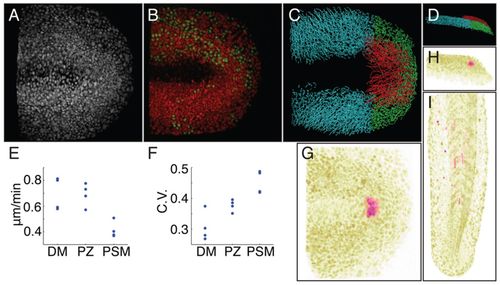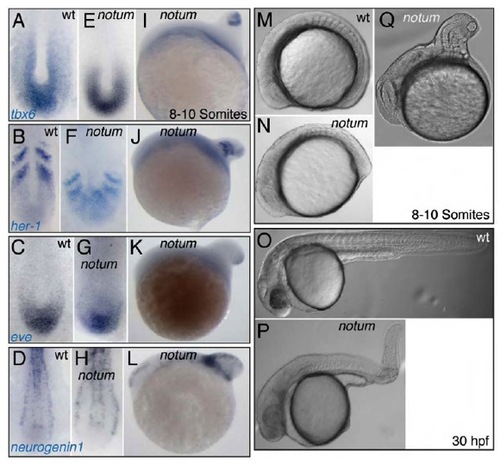- Title
-
Regulated tissue fluidity steers zebrafish body elongation
- Authors
- Lawton, A.K., Nandi, A., Stulberg, M.J., Dray, N., Sneddon, M.W., Pontius, W., Emonet, T., and Holley, S.A.
- Source
- Full text @ Development
|
Cell movement in the wild-type zebrafish tailbud. (A) Confocal image stacks of RFP-labeled nuclei were taken through time and nuclei were tracked in 4D. (B) Independent tracking of red and green double-labeled nuclei revealed cell tracking to be 85% accurate. (C) Cell tracks were divided into regions of interest: dorsal medial zone (DM; red), progenitor zone, (PZ; green), presomitic mesoderm (PSM; cyan). (D) A lateral view of the image shown in C. (E) Examination of mean track speeds. P-values calculated using ANOVA with additional validation by permutation tests. The DM and PZ speeds are equivalent (DM vs PZ, P>0.05) and are higher than PSM (DM vs PSM, P<0.05; PZ vs PSM, P<0.05). (F) The means of the coefficient of variation (CV) of track speed show that the CV increases from the DM to PZ (P<0.05) and from the PZ to PSM (P<0.05). (G-I) Two-photon labeling of DM cells at the ten-somite stage. (G) Dorsal view. (H) Lateral view. (I) After completing elongation, the uncaged cells differentiated as myofibers. A-C and G are dorsal views. In all panels, anterior is left the right except panel I in which anterior is up. |
|
Ectopic notum1a expression or SU5402 treatments perturb axis elongation. (A-M) Wild-type (A-C,F,K), notum1a-overexpressing (D,E,G,L) and SU5402-treated (H-J,M) zebrafish embryos. (C) notum1a is transcribed in the posterior DM. (D) Ectopic notum1a gives rise to a shortened axis and malformed tailbud. (E) Half of these embryos develop severely misdirected body axes. Spatial expression of tbx6 (F-H) and neurogenin1 (K-M) remains relatively normal despite notum1a overexpression (G,L) or SU5402 treatment (H,M). (I,J) SU5402 treatment gives rise to a mild axis elongation defect. (N) qPCR of dissected tailbuds after notum1a overexpression reveals reductions in transcription of dkk1 and tbx6. Student′s unpaired t-test. *P≤0.05. n=4. Error bars represent s.e.m. |
|
Loss of cadherin 2 reduces the effectiveness and coherence of cell motion in the zebrafish tailbud. (A,B) cdh2 mutants have morphologically abnormal tailbuds (A) and tails (B). (C-J) Quantitative analysis of cell motion in the tailbud of three wild-type embryos (C-F) and three cdh2 mutants (G-J). (G) MSD is reduced in the DM of cdh2 mutants (P<0.05). (H) Polarization is reduced in the DM (P<0.05), PZ (P<0.05) and PSM (P<0.05) of cdh2 mutants. (I) Correlation length is lower in the DM (P<0.05). (J) Neighbor similarity is diminished in the DM of cdh2 homozygotes. (K-N) Adherens junctions in the PZ are visualized by immunohistochemistry for β-catenin. All panels are at the same magnification; scale bar: 5 μm. The lattice of adherens junctions among cells is present in wild-type embryos (K) but is disrupted in cdh2 mutants (L). The pattern of adherens junctions in notum1a-overexpressing embryos (M) and SU5402-treated embryos (N) resembles the wild-type pattern. P-values calculated via Student′s t-test. PHENOTYPE:
|
|
notum1a over-expression phenotypes. (A-D,M,O) Wild type. (E-H,N,P) The moderate notum1a over-expression phenotype used for quantitative image analysis. (I-L,Q) The severe notum1a over-expression phenotype. The expression domains of mesodermal genes tbx6 (A,E,I) her1 (B,F,J) eve (C,G,K) and the neural gene neurogenin1 (D,H,L) remain after ectopic notum1a expression indicating that notum1a retains patterned mesodermal and neural cell fates. (P) Roughly half of ‘moderate phenotype class’ embryos at 8-10 somites give rise to misdirected body axes at 30 hpf. |




